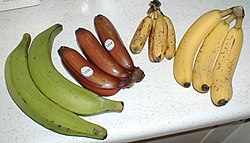Evolution and Taxonomy:
– Genus Musa was created by Carl Linnaeus in 1753.
– The origin of Musa may be in Trans–New Guinea languages.
– The word banana is thought to be of West African origin.
– Musa is the type genus in the family Musaceae.
– The name Musa may be derived from Antonius Musa.
Cultivation and Production:
– Bananas are grown in 135 countries primarily for fruit.
– India and China were top producers in 2022.
– Bananas are propagated asexually from offshoots.
– Bananas are grown in approximately 135 countries.
– Majority of bananas are cultivated for family consumption or local markets.
Uses and Classification:
– Bananas are used for food.
– Some are grown for making paper and textiles.
– Bananas are also grown as ornamental plants.
– Bananas in North America and Europe are divided into sweet dessert bananas and starchy plantains.
– Small farmers in Colombia grow a wider range of cultivars than large plantations.
History and Spread:
– Domestication of bananas started with naturally occurring seedless individuals of Musa banksii in New Guinea.
– Bananas spread from Island Southeast Asia to Oceania, East Africa, South Asia, and Indochina.
– Bananas became staple crops for Austronesian peoples and spread through ancient maritime trading routes.
– Southeast Asia remains the primary region of banana diversity.
– Bananas were introduced to Africa, South Asia, and Indochina through ancient voyages.
Commercial Cultivation and Ripening:
– Modern plantations originated in Jamaica and the Western Caribbean Zone.
– Companies like Chiquita and Dole monopolized the banana industry.
– Bananas are transported long distances from the tropics to world markets.
– Export bananas are picked green and ripened in special ethylene-filled rooms.
– Ethylene gas induces ripening by breaking down starch into sugar.
A banana is an elongated, edible fruit – botanically a berry – produced by several kinds of large herbaceous flowering plants in the genus Musa. In some countries, cooking bananas are called plantains, distinguishing them from dessert bananas. The fruit is variable in size, color, and firmness, but is usually elongated and curved, with soft flesh rich in starch covered with a rind, which may have a variety of colors when ripe. The fruits grow upward in clusters near the top of the plant. Almost all modern edible seedless (parthenocarp) bananas come from two wild species – Musa acuminata and Musa balbisiana. Most cultivated bananas are M. acuminata, M. balbisiana, or hybrids of the two.
| Banana | |
|---|---|
 Fruits of four different cultivars. Left to right: plantain, red banana, apple banana, and Cavendish banana | |
| Source plant(s) | Musa |
| Part(s) of plant | Fruit |
| Uses | Food |
Musa species are native to tropical Indomalaya and Australia; they were probably domesticated in New Guinea. They are grown in 135 countries, primarily for their fruit, and to a lesser extent to make banana paper and textiles, while some are grown as ornamental plants. The world's largest producers of bananas in 2022 were India and China, which together accounted for approximately 26% of total production. Bananas are eaten raw or cooked in recipes varying from curries to banana chips, fritters, fruit preserves, or simply baked or steamed.
Worldwide, there is no sharp distinction between dessert "bananas" and cooking "plantains": this works well enough in the Americas and Europe, but it breaks down in Southeast Asia where many more kinds of bananas are grown and eaten. The term "banana" is applied also to other members of the genus Musa, such as the scarlet banana (Musa coccinea), the pink banana (Musa velutina), and the Fe'i bananas. Members of the genus Ensete, such as the snow banana (Ensete glaucum) and the economically important false banana (Ensete ventricosum) of Africa are sometimes included. Both genera are in the banana family, Musaceae.
Banana plantations are subject to damage by parasitic nematodes and insect pests, and to fungal and bacterial diseases, one of the most serious being Panama disease which is caused by a Fusarium fungus. This and black sigatoka threaten the production of Cavendish bananas, the main variety eaten in the Western world. Plant breeders are seeking new varieties, but these are difficult to breed given that commercial varieties are seedless. To enable future breeding, banana germplasm is conserved in multiple gene banks around the world.
